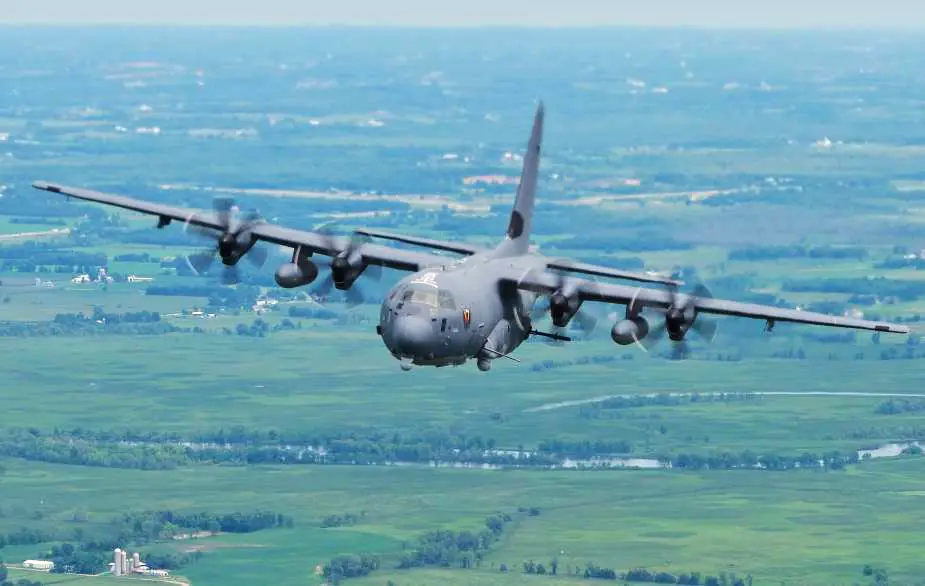A U.S. Air Force AC-130J Ghostrider attacked an Iran-backed militant group after the group used a ballistic missile to attack U.S. and coalition forces on Al-Asad Airbase, Iraq, the deputy Pentagon press secretary said on November 21 quoted by C. Todd Lopez.
Follow Air Recognition on Google News at this link
 AC-130J Ghostrider assigned to the 4th Special Operations Squadron, Hurlburt Field, Fla. (Picture source: U.S. Air Force/Master Sgt. Christopher Boitz)
AC-130J Ghostrider assigned to the 4th Special Operations Squadron, Hurlburt Field, Fla. (Picture source: U.S. Air Force/Master Sgt. Christopher Boitz)
The ballistic missile attack resulted in non-serious injuries to U.S. and coalition forces, as well as minor damage to infrastructure on the installation, said Sabrina Singh during a briefing at the Pentagon. "Immediately following the attack, a U.S. military AC-130 aircraft in the area conducted a self-defense strike against an Iranian-backed militia vehicle and a number of Iranian-backed militia personnel involved in this attack," she said. "This self-defense strike resulted in some hostile fatalities."
Singh said the AC-130J gunship was able to mount a response so quickly because it was already in the air at the time of the missile attack. "We were able to identify the point of origin of these attacks because an AC-130 was up already in the area and therefore was able to respond," Singh said. "They were able to take action because they saw the militants. They were able to keep an eye on the movement of these militants as they moved into their vehicles and that's why they were able to respond."
Since Oct. 17, U.S. forces have been attacked 66 times in both Iraq and Syria, said Singh. She also said this is the first time a ballistic missile similar to the one used in this attack has been employed.
Since the start of those attacks in October, the U.S. has mounted three other strikes, Singh said. But those strikes were pre-planned and targeted specific facilities and infrastructure known to be used by militias affiliated with the Islamic Revolutionary Guard Corps. This most recent U.S. response was different in that it was unplanned. "These groups have targeted our forces both Iraq and Syria," Singh said. "We feel right now that we've taken appropriate action to decimate some of their facilities and some of their weapons ... We always reserve the right to respond at a time and place of our choosing."
Lockheed Martin AC-10J Ghostrider
The AC-130J Ghostrider is a highly versatile aircraft designed for a variety of critical missions, which include close air support, air interdiction, and armed reconnaissance. These missions encompass a wide range of operational scenarios, making the AC-130J a valuable asset for ground forces. It excels in delivering precision firepower, maintaining a persistent presence in the operational theater, and adapting to different mission requirements.
One of its primary roles is Close Air Support (CAS), where it plays a crucial role in providing air support to troops engaged in active combat situations. This includes tasks such as escorting convoys, safeguarding specific points, and responding rapidly to requests for air defense. The AC-130J serves as a dependable guardian for ground forces, offering precise and timely firepower when it's needed the most.
In addition to CAS, the AC-130J is well-suited for Air Interdiction missions. These missions involve disrupting and hindering enemy activities through the targeted engagement of pre-planned or opportunistic targets. The aircraft's capabilities in this area encompass strike coordination, reconnaissance, and overwatch duties, all of which contribute to achieving mission success.
Furthermore, the AC-130J is equipped for Armed Reconnaissance, providing enhanced intelligence-gathering capabilities while maintaining a vigilant eye on the operational environment. Its advanced features and technology enhance situational awareness, thereby augmenting overall operational effectiveness.
Key features of the AC-130J Ghostrider include its state-of-the-art avionics. The aircraft features an advanced two-pilot flight station equipped with fully integrated digital avionics, ensuring precise navigation and seamless mission execution. Its navigation systems are particularly noteworthy, with dual inertial navigation systems and a global positioning system that enable the aircraft to navigate with remarkable accuracy.
To enhance its operational capabilities, the AC-130J is equipped with integrated defensive systems for protection and a color weather radar system that improves situational awareness. Additionally, the aircraft can be refueled in-flight using the Universal Air Refueling Receptacle Slipway Installation system, extending its operational range and endurance.
The Precision Strike Package is a crucial modification to the AC-130J, providing it with a mission management console, a robust communication suite, electro-optical/infrared sensors, advanced fire control equipment, and the capability to deliver precision-guided munitions. It is also armed with trainable 30mm and 105mm weapons, making it highly effective in engaging ground targets with precision.
To streamline operations, the AC-130J features a mission management system that integrates sensor data, communication, environmental information, order of battle, and threat intelligence into a cohesive operational picture. This integration enhances mission effectiveness and ensures seamless coordination during complex operations.
In historical context, the AC-130J Ghostrider represents the fifth generation of gunships, serving as a successor to the aging AC-130U/W gunship fleet. These gunships have a storied history dating back to the Vietnam War, where they played a pivotal role in destroying thousands of enemy trucks and providing life-saving close air support. Over the decades, AC-130s have been consistently deployed to hotspots around the world, supporting both special operations and conventional forces in regions such as South America, Africa, Europe, and the Middle East, where they have made significant contributions to mission success.
















